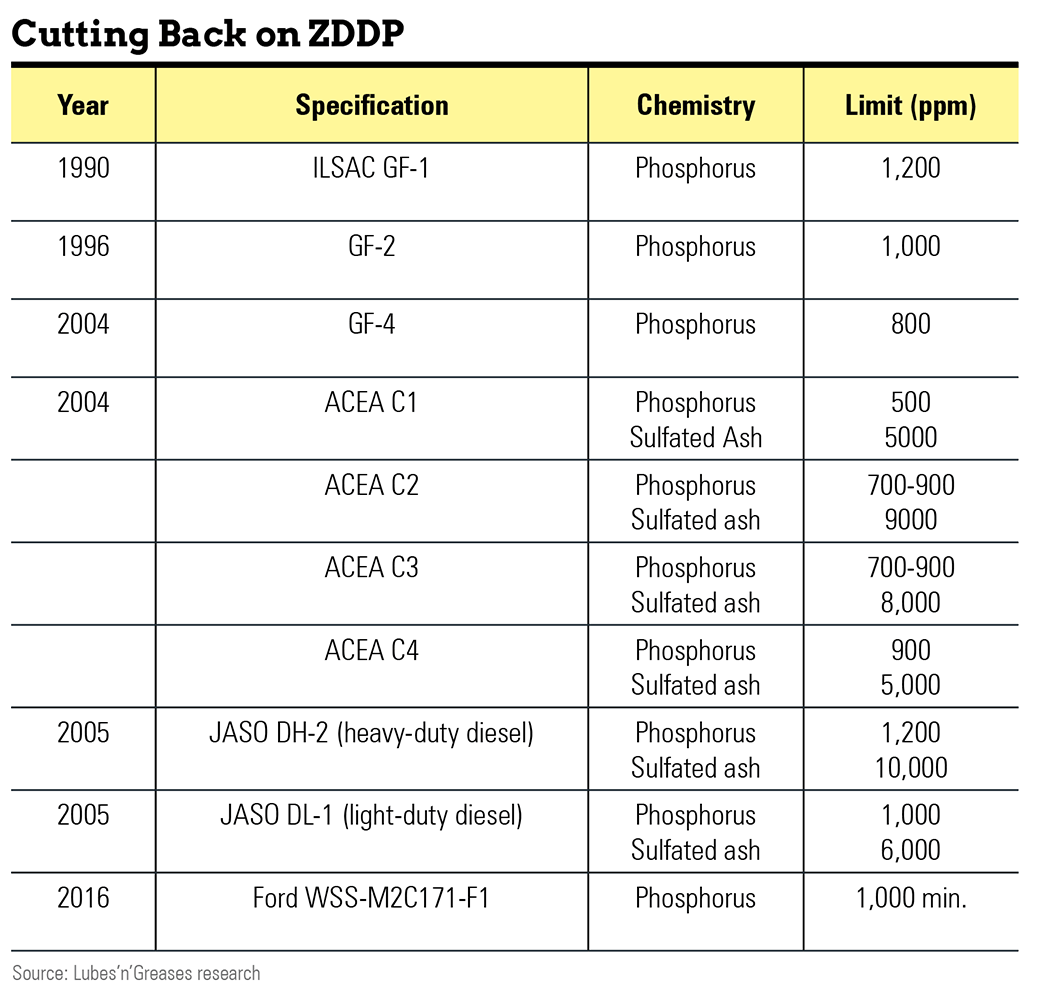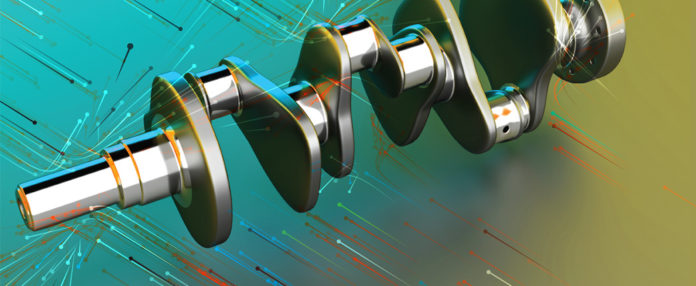A couple decades ago, engine oil formulators were faced with a sobering prospect: Automobile emissions regulations threatened to steal, or at least compromise, the industry’s main weapon in the fight against wear—zinc dialkyldithiophosphate. Within the lubricant and automobile industries, there was consensus that formulators needed to lessen dependence on ZDDP and develop substitute chemistries. Only the first part of that equation went as anticipated, and yet formulators were able to meet the challenge, thanks to a number of other developments.
Emissions regulations have been impacting lubricants for so long that they seem like a permanent influence on the industry. But the nature of their impact has evolved. Today, the regulatory focus is on global warming, and rules for automobiles aim to reduce carbon dioxide emissions mostly by improving fuel economy or by encouraging a switch to vehicles that run on cleaner power, such as electricity or natural gas.
Back in the ‘90s and 2000s, regulators were tackling problems such as smog, acid rain and depletion of the ozone layer. They did this by setting and repeatedly ratcheting down limits on emissions of several types of pollutants: hydrocarbon particles, commonly known as soot, which make air unhealthy to breathe; sulfur oxides, which cause acid rain; and nitrous oxides, which deplete the ozone layer and contribute hundreds of times more heavily to global warming than CO2.
Automakers attacked these substances by implementing a series of emissions control technologies. Exhaust gas recirculation reduces NOx emissions by directing exhaust back to piston chambers where it dampens combustion temperatures, thereby reducing generation of NOx. Three-way catalysts convert NOx to nitrogen and oxygen, carbon monoxide to carbon dioxide, and hydrocarbons to water. Selective catalytic reduction also breaks down NOx.
ZDDP is one of the oldest antiwear chemical additives and also one of the most effective. Under pressure and in the presence of heat, the phosphorus that it carries forms a film on metal surfaces that help protect them against boundary friction. To make it even more valuable, ZDDP also helps prevent oxidation and corrosion.
Unfortunately, the chemical is about as tough on emissions control technologies as it is on wear. Phosphorus tends to poison three-way catalysts and selective catalytic reduction, while ash clogs particulate filters. In the eyes of automakers, it was absolutely necessary to protect these systems due to the severity of penalties attached to emissions regulations—even if it meant messing with a key part of engine oil performance like protection from wear.
“There definitely was some concern,” said Angela Willis, sole proprietor of Willis Advanced Consulting. Before starting that business, she spent 23 years working on lubrication at General Motors. “Antiwear is a core part of engine oil performance, and everyone recognized that it was going to be difficult to replace ZDDP because it was so effective at antiwear, and it also contributed as an antioxidant.”
Nevertheless, the industry did cut back on ZDDP for a couple decades. When the International Lubricant Standardization and Advisory Committee adopted the ILSAC GF-1 light-duty engine oil specification in 1990, it included a limit of 1,200 parts per million for phosphorus, effectively capping ZDDP content. Six years later, it lowered that limit to 1,000 ppm for adoption of GF-2, and in 2004 the organization reduced the limit again to 800 ppm for GF-4. There was debate about lowering the GF-4 limit to 500 ppm, but ultimately the industries decided not to go that far.

ILSAC includes representatives of American and Japanese automakers and develops light-duty engine oil standards.
Other engine oil standard developers took similar tacks. In 2004, the European Automobile Manufacturers’ Association created a new category of oil sequences, ACEA C, for vehicles equipped with technologies such as particulate filters and three-way catalysts. ACEA C1 defines oils that accommodate aftertreatment systems in high performance gasoline- and diesel-powered light-duty vehicles that also contribute to high fuel economy. That category has a phosphorus limit of 500 ppm and a sulfated ash limit of 5,000 ppm.
ACEA C2 is also intended for oils that provide fuel economy benefits in light-duty vehicles with aftertreatment systems, but it allows phosphorus levels of 700-900 ppm and up to 9,000 ppm sulfated ash. ACEA C3 and ACEA C4 do not require a fuel economy contribution. C3 allows between 700 and 900 ppm phosphorus and up to 8,000 ppm sulfated ash, while C4 caps phosphorus at 900 ppm and limits sulfated ash to 5,000 ppm.
Engine oil antiwear performance levels have continued to rise over the past couple decades, even as ZDDP levels fell. So what provided this additional performance? For the most part, it was not new additive chemistries as industry insiders had predicted. Numerous organizations researched and sought to develop products, and some were commercialized, but industry insiders say few have been widely deployed. Much of that owes to the multi-faceted usefulness of ZDDP. Cutting back on the chemical affects not only antiwear performance, but also antioxidancy and corrosion inhibition, so multiple parts of a formula need to be adjusted.
Cost is also an issue. Any significant change in automotive engine oil formulation requires formulators to redo testing to prove performance levels defined by product specifications. Engine tests in such specs can be very expensive, generating bills of millions of dollars—and that’s just if final tests are passed the first time around. The tab increases if you also consider tests conducted during development and if any tests need to be rerun.
Any replacement chemistries also inevitably raise formulation costs, partly because ZDDP is so economical, and that reduces the appeal of new products.
“ZDDPs afford a highly cost-effective route to both wear protection and oxidation control,” said Ian Bell, senior research and development director at additive supplier Afton Chemical Corp. “These benefits result in a very high barrier to replacement by new and different chemistries—hence why the path of phosphorus reduction has leveled off at the low, but above-zero, level of 0.08%. Not only would additional antiwear chemistry be needed to replace ZDDP, but one would also require significantly higher treat rates of antioxidants that bring other challenges, as well as the obvious increased cost.”
Instead, the lubricant and auto industries found a number of ways to improve antiwear performance with lower levels of the main agent for that performance. For one thing, additive companies found that some varieties of ZDDP are more effective than others. In particular, aryl varieties are slower to form up into a protective film than alkyl varieties. Also, primary alkyl ZDDPs are more volatile than secondary alkyl types, meaning that they tend to evaporate, leading to a decrease in performance.
|
“The shift to better base oils has been a big factor. Things like that allow you to have a lower treat rate of your additives.”
– Angela Willis, Willis Advanced Consulting
|
“Over the years, we have seen the balance of ZDDP deployed change,” Bell said. “Aryl ZDDPs are seldom seen now. With the introduction of phosphorus retention, we observed a reduction of the more volatile primary ZDDP, with secondary alkyl ZDDPs being the heart of the formulation.”
Automakers have won relief from some antiwear demands due to changes in engine design. Cam followers were long a major point of concern because the sliding followers used by many original equipment manufacturers were particularly susceptible to wear. Now many OEMs have switched to rolling followers, which wear less.
“Design changes have made a significant difference” in antiwear requirements, said Steven Haffner, president of SGH Consulting LLC and formerly of Infineum. “You don’t have much valve train wear now because most OEMs are not using sliding followers. For rolling followers, 800 [ppm phosphorus] is perfectly adequate.”
There has also been a great deal of work to develop various types of coatings for a range of engine components. This work continues, but sources said results are already giving automakers an additional tool to help prevent wear.
Aid in the battle against wear also came from a shift in the types of base stocks used to formulate engine oils—from API Group I oils to more highly refined stocks. Group II+ and Group III oils have more favorable traction coefficients, which helps protect against wear from boundary friction, according to Willis.
“The shift to better base oils has been a big factor,” she told Lubes’n’Greases. “Things like that allow you to have a lower treat rate of your additives.”
Finally, while there has not been widespread benefits from new antiwear chemistries, sources agreed that friction modifiers have made significant contributions in the fight against wear.
Taking everything into account, industry sources said that lubricant formulators have been able to provide satisfactory levels of antiwear performance despite having to tighten up on their use of ZDDP. They also agreed that the situation is at a point of stasis now for light-duty engines. Existing phosphorus and sulfated ash levels seem to accommodate exhaust aftertreatment systems, and automakers seem to be prioritizing improvement of performance parameters other than antiwear.
“I think the influential OEMs are satisfied with where things are now,” said Willis. “There’s not a big push at the moment for more antiwear performance, and they’re also not looking for further reductions in ZDDP.”
Issues may loom for heavy-duty engines, though. Emissions regulations for big trucks have run behind those for passenger cars but are ramping up now. In addition, most heavy-duty engines run on diesel, which makes for a more abrasive environment than gasoline.
“We probably are facing a need for more wear protection in diesel-powered trucks,” said Ron Romano, lubricant expert at Ford Motor Co. “If regulations do start driving further reductions in emissions, and if aftertreatment systems do become more sensitive to phosphorus or ash, that’s the point where we might start to need supplemental additive chemistries.”
Perhaps those who anticipated new antiwear chemistries two decades ago may yet turn out to be correct.
Tim Sullivan is executive editor for Lubes’n’Greases. Contact him at Tim@LubesnGreases.com.
